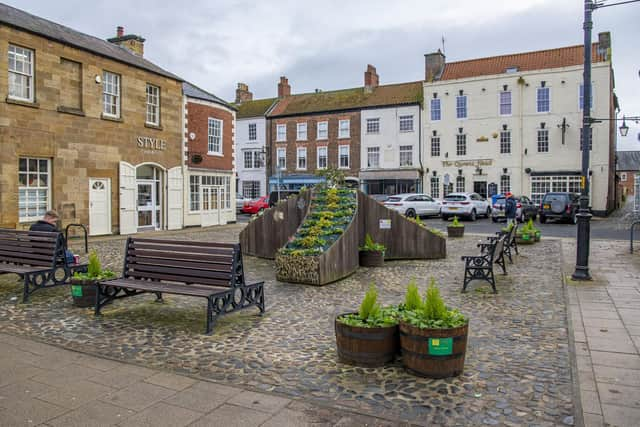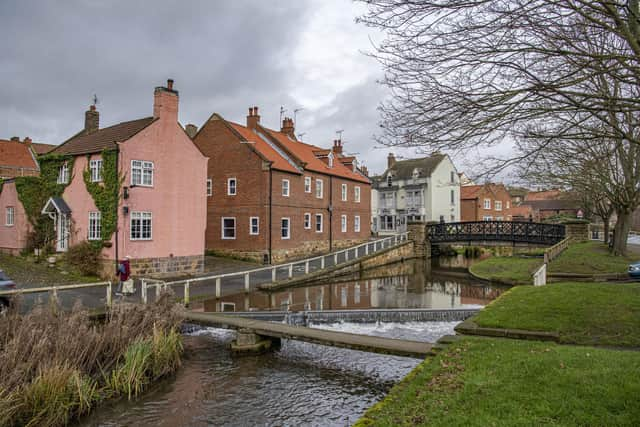Village of the Week: Skeletons in Stokesley and a directory of traders make past and present thrive
Nowadays, it is still one of the most popular places for visitors in North Yorkshire with it being near to the birthplace of Captain Cook and Roseberry Topping.
A thriving centre, it still trades as a market town and is lined with independent high end shops, restaurants, quaint and traditional pubs, cafes and boutiques - all housed in Victorian or earlier buildings that are Grade I or II listed and of special architectural or historic interest.
Advertisement
Hide AdAdvertisement
Hide AdEven on windswept, winter days it is a busy area with the amenities that locals in the more rural towns and villages need, such as a health centre, library, fire and police station, business units, supermarket, churches, schools and sports teams.


On a Friday you will find a weekly market and a farmer’s market takes place on Saturdays.
There is a population of maybe more than 4,700 people with a varied demographic and houses for sale and are a mix of family homes on new developments, bungalows and modern apartment conversions in older buildings.
All these factors will contribute to the sustainability of Stokesley for many more years to come, but the past of Stokesley also makes for quite a tale.
Advertisement
Hide AdAdvertisement
Hide AdUnlike many places featured on these pages, knowledge of Stokesley goes back to the 11th century when it was said to be a 'manor' of considerable importance.


An entry in the Domesday Book, under the heading “Land of the King’s Thegns” says: “In Stocheslage (Stokesley), Hawart had 6 carucates of land for geld. Land for 3 ploughs. Uctred has 1 plough there, and 8 villeins with 4 ploughs. A priest (is) there, and a church, and 1 mill of 10s. (annual value), and 8 acres of meadow. (It is) 1 league in length and half (a league) in breadth. T.R.E. it was worth £24; now (it is worth) £8.”
Guy de Balliol, the founder of the long line of Balliol lords of Barnard Castle, was granted the barony of Stokesley, probably by King William Rufus in the late 11th century. From about 1250, the Eure family were lords of the manor of Stokesley. It remained in the hands of that family until about 1622 when William, Lord Eure, sold Stokesley to Richard Forster.
In that time, Stokesley had also been granted a charter to hold fairs in 1223 by Henry III.
Advertisement
Hide AdAdvertisement
Hide AdSome other snippets documented in local history records would suggest that there was more wealth in Stokesley than its closes neighbours – measured by a hearth tax.
The Hearth Tax of 1673 sys that, in “Stoxley” 80 houses had one or two hearths. An additional 15 houses with just one hearth were discharged by legal certificate from paying the hearth tax. 18 properties in Stokesley had three or four hearths, far more than in most of the villages of the Cleveland Plain. Similarly, there were eight properties with five or six hearths, while some Cleveland villages didn’t even have one such grand house. There was a seven hearth property belonging to “Dr Pennyman” and an 11-hearth mansion belonging to ”The Lady Foster”.
The Cleveland and Teesside Local History Society also has a detailed record of what you could find trading in Stokesley.
Pigot’s 1829 Directory said there were eight grocers and drapers, four butchers, nine shopkeepers, four bakers and flour dealers,11 boot and shoe makers, six milliners, three tailors, two chemists, two watch and clock makers, one bookseller, two hairdressers, and two chemists. There were also three tallow chandlers, three saddlers, four blacksmiths, two whitesmiths, two wheelwrights and two coopers.
Advertisement
Hide AdAdvertisement
Hide AdAmong the professions there were four surgeons, three attorneys. There were also two auctioneers, a gun maker, a glover, a clog and pattern maker, a hatter and a stay-maker. According to Ward’s Directory of 1936, Stokesley had seven grocers, six butchers, three fruiterers, two confectioners, two drapers, two tailors, three bootmakers, a chemist, a newsagent, a hardware dealer, two watchmakers, a saddler, two blacksmiths and two wireless dealers.
As well as this, Stokesley Local History Group has a timeline of events from 1860 to 2004 which is charming and relatable for Stokesley people who will recall some.
“1860 - Summer very wet. Rain fell almost incessantly for three months. Last thatched roofs in Stokesley — on West Row near the Masonic Hall - were replaced.”
“1862 - February 10th — Human skeleton found at Parish Creyke farm near Stokesley, in the remains of the heating chamber of a Roman Villa.”
Advertisement
Hide AdAdvertisement
Hide Ad“1863 - March 10th - Prince of Wales [later Edward Vll] and Princess Alexandra of Denmark marry — Stokesley celebrates with a tea for all Children under 14 years. The poor in the workhouse, and those on out-door relief given a good dinner. A Ball was held in the Town Hall. Old English sports and pastimes, and a procession of the Oddfellows Friendly Society.
“1864 - May 27th — Mr John Newball, lately entered in the Three Tuns Inn was found quite dead, having hung himself in his bedroom. Deceased was for many years a postboy in this town, in which capacity he was highly regarded [he had been] in a moody state of mind for some days, when it was said he had been disappointed in marriage…”
“1865 - A tricycle made by Wright and Rowntree, blacksmiths in Stokesley, and a bicycle made by Rowntree, were raced up and down the High Street. lt made a grand entertainment for the townspeople.”
1930 - July heavy rain causing much flooding, Stokesley high under water.
Advertisement
Hide AdAdvertisement
Hide Ad1980 - Howgarth & West chemist calls it a day after ninety one year's business taken over from the late Robert Calver Noel age 66 years, John age 64 years and Eric age 60 years. Notice of closure Evening Gazette 30 October 1980.
2004 - Site of United bus depot turned into flats.”
